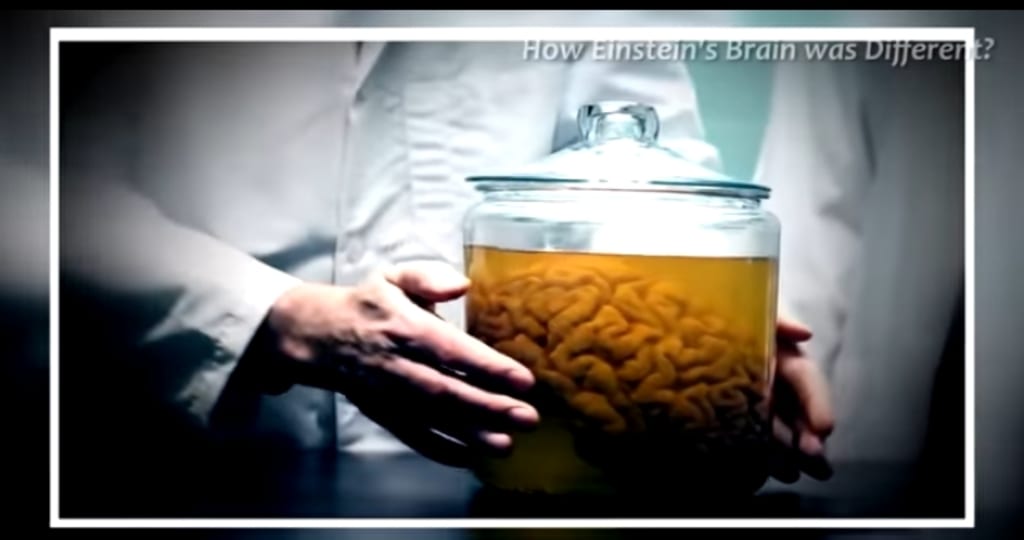Why einstein brain was stolen
Einstein's brain is a story steeped in riddle, contestation, and conspiracy. The tale begins with the death of the celebrated physicist Albert Einstein on April 18, 1955, at the age of 76. Shortly after his end, Thomas Stoltz Harvey, the pathologist who performed the necropsy at Princeton Hospital in New Jersey, did commodity largely unconventional he removed Einstein's brain for scientific study.

Einstein's brain is a story steeped in riddle, contestation, and conspiracy. The tale begins with the death of the celebrated physicist Albert Einstein on April 18, 1955, at the age of 76. Shortly after his end, Thomas Stoltz Harvey, the pathologist who performed the necropsy at Princeton Hospital in New Jersey, did commodity largely unconventional he removed Einstein's brain for scientific study.
Harvey's decision to take Einstein's brain without authorization from his family raises ethical questions that continue to be batted moment. Some argue that Harvey acted out of scientific curiosity, hoping to unleash the secrets of Einstein's genius. Others suggest further dubious motives, similar as seeking fame or profit. Anyhow of his intentions, Harvey's conduct burned a decades-long saga involving Einstein's brain. originally, he claimed to have attained concurrence from Einstein's son, Hans Albert,
but latterly admissions cast mistrustfulness on the veracity of this assertion. The Einstein family was reportedly ignorant of the brain's junking until times latterly, sparking outrage and legal battles over its power and disposition. Following the necropsy, Harvey embarked on a crazy trip with Einstein's brain.
He deconstructed it into hundreds of pieces, conserving some in formaldehyde and transferring others to experimenters around the world. still, his sweats failed to yield any groundbreaking perceptivity into Einstein's intellect or creativity. Despite the lack of scientific improvements, Einstein's brain continued to allure the public imagination. In 1999, intelligencer Michael Paterniti told the odyssey of Einstein's brain in his book" DrivingMr.
Albert A Trip Across America with Einstein's Brain." The book details the surreal road trip accepted by Paterniti and Harvey's successor,Dr. Thomas Harvey, who carried Einstein's brain in a Tupperware vessel filled with formaldehyde. Paterniti's book thrust the saga of Einstein's brain back into the limelight, reigniting interest in its whereabouts and fate.
The renewed attention urged the National Museum of Health and Medicine in Silver Spring, Maryland, to intimately admit that it held a collection of Einstein's brain towel. The gallery had entered the samples from Harvey after his death in 2007.
In 2010, the gallery allowed a platoon of experimenters led byDr. Dean Falk, a prominent neuroscientist, to conduct a comprehensive study of Einstein's brain. Their findings, published in the journal" Brain," revealed unique features that distinguished Einstein's brain from those of average individualities. specially, Einstein's parietal lobes, responsible for fine and spatial logic, displayed an unusual pattern of complications known as" gyri" and" sulci." This anatomical quip led some to presume that it might have contributed to Einstein's extraordinary cognitive capacities.
still, the study's conclusions remain contentious within the scientific community. Critics argue that attributing Einstein's genius solely to the structure of his brain oversimplifies the complex interplay of genetics, terrain, and parenting in shaping intellectual prowess. The ethical counteraccusations of studying Einstein's brain extend beyond issues of concurrence and sequestration. Some scholars advise against reducing Einstein's heritage to a bare neurological curiosity, advising against the fetishization of genius and the perpetuation of scientific myths.
They argue that fastening too hardly on the physical attributes of Einstein's brain obscures the broader socio-artistic factors that enabled his groundbreaking benefactions to drugs. likewise, the commodification of Einstein's brain raises disquieting questions about the ethics of collecting and displaying mortal remains. Critics contend that treating Einstein's brain as a scientific relic or sightseer magnet diminishes his humanity and reinforces a culture of scientific voyeurism. In recent times, sweats have been made to return Einstein's brain to his family for proper burial. In 1998, Harvey's heirs at law reached an agreement with the Einstein family to transfer guardianship of the brain to the factor of Harvey's estate, who pledged to recognize the family's wishes regarding its final resting place. still, regulatory hurdles and legal controversies have delayed the extradition process, leaving Einstein's brain in limbo. The saga of Einstein's brain serves as a exemplary tale about the ethical dilemmas essential in scientific exploration and the complex interplay of wisdom, culture, and ethics. It reminds us of the need for lesser translucency, responsibility, and perceptivity in handling mortal remains and conducting biomedical exploration. Eventually, the story of Einstein's brain isn't just a scientific riddle but a poignant reflection of our seductiveness with genius and the enduring heritage of one of history's topmost minds.





Comments
There are no comments for this story
Be the first to respond and start the conversation.